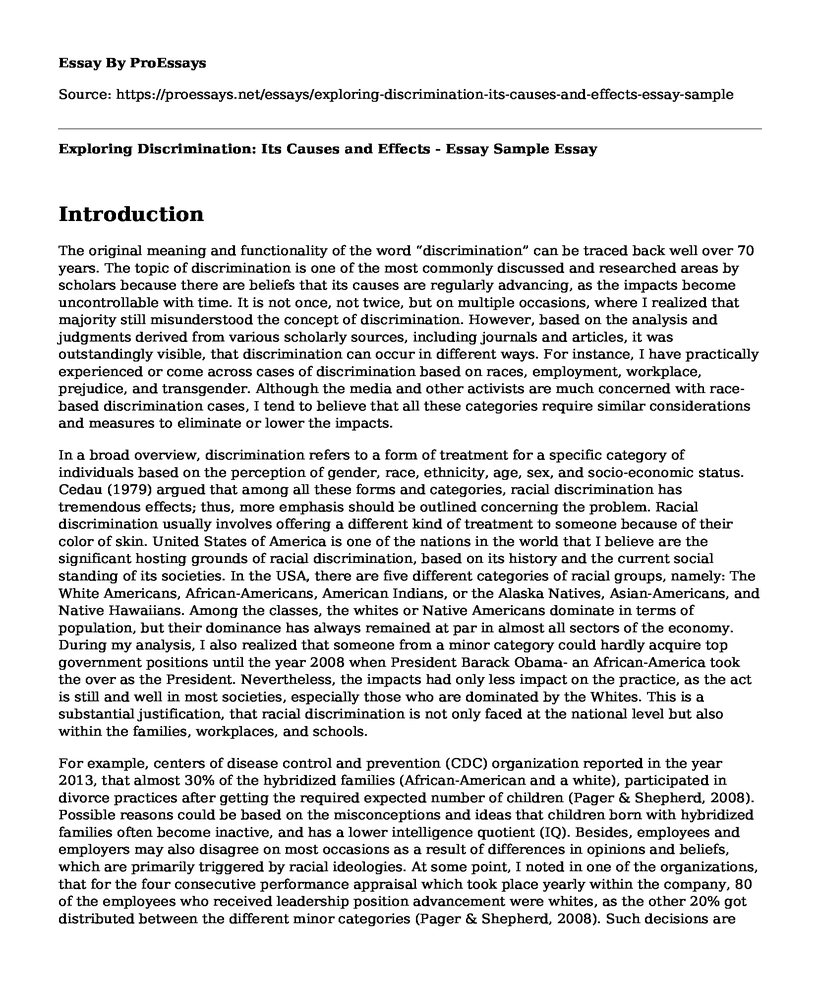Introduction
The original meaning and functionality of the word “discrimination” can be traced back well over 70 years. The topic of discrimination is one of the most commonly discussed and researched areas by scholars because there are beliefs that its causes are regularly advancing, as the impacts become uncontrollable with time. It is not once, not twice, but on multiple occasions, where I realized that majority still misunderstood the concept of discrimination. However, based on the analysis and judgments derived from various scholarly sources, including journals and articles, it was outstandingly visible, that discrimination can occur in different ways. For instance, I have practically experienced or come across cases of discrimination based on races, employment, workplace, prejudice, and transgender. Although the media and other activists are much concerned with race-based discrimination cases, I tend to believe that all these categories require similar considerations and measures to eliminate or lower the impacts.
In a broad overview, discrimination refers to a form of treatment for a specific category of individuals based on the perception of gender, race, ethnicity, age, sex, and socio-economic status. Cedau (1979) argued that among all these forms and categories, racial discrimination has tremendous effects; thus, more emphasis should be outlined concerning the problem. Racial discrimination usually involves offering a different kind of treatment to someone because of their color of skin. United States of America is one of the nations in the world that I believe are the significant hosting grounds of racial discrimination, based on its history and the current social standing of its societies. In the USA, there are five different categories of racial groups, namely: The White Americans, African-Americans, American Indians, or the Alaska Natives, Asian-Americans, and Native Hawaiians. Among the classes, the whites or Native Americans dominate in terms of population, but their dominance has always remained at par in almost all sectors of the economy. During my analysis, I also realized that someone from a minor category could hardly acquire top government positions until the year 2008 when President Barack Obama- an African-America took the over as the President. Nevertheless, the impacts had only less impact on the practice, as the act is still and well in most societies, especially those who are dominated by the Whites. This is a substantial justification, that racial discrimination is not only faced at the national level but also within the families, workplaces, and schools.
For example, centers of disease control and prevention (CDC) organization reported in the year 2013, that almost 30% of the hybridized families (African-American and a white), participated in divorce practices after getting the required expected number of children (Pager & Shepherd, 2008). Possible reasons could be based on the misconceptions and ideas that children born with hybridized families often become inactive, and has a lower intelligence quotient (IQ). Besides, employees and employers may also disagree on most occasions as a result of differences in opinions and beliefs, which are primarily triggered by racial ideologies. At some point, I noted in one of the organizations, that for the four consecutive performance appraisal which took place yearly within the company, 80 of the employees who received leadership position advancement were whites, as the other 20% got distributed between the different minor categories (Pager & Shepherd, 2008). Such decisions are usually made, using a misguided argument that small groups should not earn the same amount of salaries as whites, or that they should not occupy leadership positions.
Conclusion
In conclusion, the topic of discrimination is vast and would require a comprehensive evaluation to gain a better and logical understanding. Meanwhile, the impacts of racial discrimination, which have been highlighted in this discussion, are crucial. They should be addressed to limit the implications, as more measures are being put forth to curb the challenge.
References
Cedaw, U. (1979). Convention on the elimination of all forms of discrimination against women. Retrieved April 20, 2006. http://www.bayefsky.com/reports/zimbabwe_cedaw_c_zwe_1_1996.pdf
Pager, D., & Shepherd, H. (2008). The sociology of discrimination: Racial discrimination in employment, housing, credit, and consumer markets. Annu. Rev. Social, 34, 181-209. https://www.annualreviews.org/doi/abs/10.1146/annurev.soc.33.040406.131740
Cite this page
Exploring Discrimination: Its Causes and Effects - Essay Sample. (2023, Aug 23). Retrieved from https://proessays.net/essays/exploring-discrimination-its-causes-and-effects-essay-sample
If you are the original author of this essay and no longer wish to have it published on the ProEssays website, please click below to request its removal:
- The Role of Social Media in Peoples Revolution
- Paper Example on Poverty and Effects On Child and Family
- Essay Sample on Transportation Industry
- Are African-Americans the Target for Racial Prejudice or They Have Always Been Free?
- Annotated Bibliography: Teenage Obesity
- Essay Example on Abortion Laws: Good and Bad Consequences
- Black Men and Public Space - Article Analysis Essay







